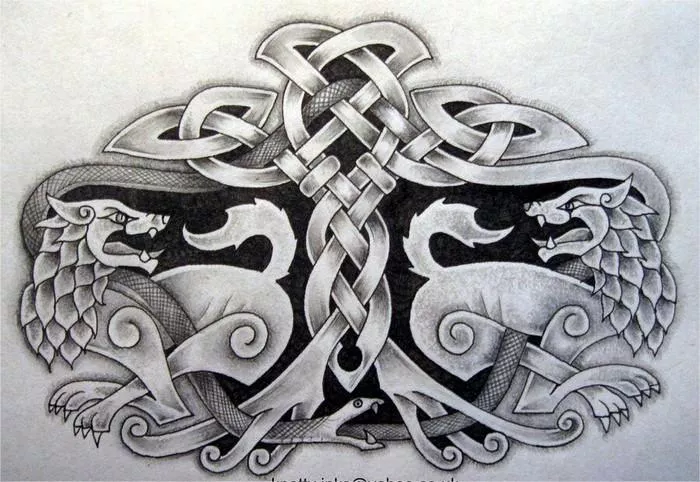Origins and Cultural Context:
Tattoos have been a form of self-expression and cultural identity for centuries, deeply intertwined with the historical narratives and societal structures of various civilizations. The origins of Norse and Celtic tattoos are rooted in the rich tapestry of European history, each tradition reflecting the unique cultural contexts in which they emerged.
Norse tattoos, also known as Viking tattoos, find their origins in the ancient Scandinavian societies of the Norsemen, who inhabited regions such as present-day Denmark, Norway, and Sweden. The Norse people, renowned for their seafaring prowess and warrior culture, imbued their tattoos with meanings of bravery, honor, and connection to their gods and ancestors.
In contrast, Celtic tattoos trace their roots to the Celtic peoples of Iron Age Europe, particularly those inhabiting regions such as Ireland, Scotland, Wales, and Brittany. The Celts were skilled artisans, and their intricate knotwork, spirals, and animal motifs reflected their deep spiritual beliefs, connection to nature, and reverence for the cycles of life.
Design Elements:
Distinct design elements characterize Norse and Celtic tattoos, reflecting the respective mythologies, symbols, and cultural motifs of each tradition.
Norse tattoos often feature runes, the ancient Germanic alphabet used by the Norsemen. These symbols, each with its own significance and power, are often associated with concepts such as strength, protection, and wisdom. Additionally, Norse tattoos frequently incorporate imagery from Norse mythology, including depictions of legendary creatures such as Odin’s ravens, Thor’s hammer, and the mighty tree Yggdrasil, which symbolizes the interconnectedness of all things.
Celtic tattoos are renowned for their intricate knotwork, characterized by endless loops and patterns symbolizing the eternal cycle of life, death, and rebirth. Knotwork designs often intertwine with depictions of animals, such as the stag or boar, which hold symbolic significance in Celtic mythology. Spirals are another common motif in Celtic tattoos, representing spiritual growth, journeying, and the cyclical nature of existence.
Symbolism and Meanings:
The symbolic meanings associated with Norse and Celtic tattoos are deeply ingrained in the spiritual and cultural beliefs of their respective societies.
Norse tattoos carry meanings of courage, resilience, and connection to the divine. Runes, in particular, are believed to harness the power of the gods, offering protection and guidance to those who bear them. Symbols like Mjölnir, the hammer of Thor, represent strength and the defense against evil forces, while depictions of Odin’s ravens, Huginn and Muninn, symbolize wisdom and the pursuit of knowledge.
Celtic tattoos are imbued with symbolism related to nature, spirituality, and the interconnectedness of all living things. Knotwork designs, with their endless loops and interwoven patterns, symbolize the eternal cycle of life, death, and rebirth. Celtic crosses, adorned with intricate knotwork, are potent symbols of faith, spirituality, and the union of the earthly and divine realms.
Geographical Influence:
The geographical ties of Norse and Celtic tattoos are evident in the historical interactions and migrations of their respective peoples.
Norsemen, through their extensive seafaring expeditions and conquests, left a lasting imprint on regions such as Scotland, Ireland, and the Isle of Man. The Norse settlement of these areas influenced Celtic art, resulting in the fusion of Norse and Celtic artistic motifs and cultural practices. This interplay between Norse and Celtic traditions is reflected in the artistic expressions found in archaeological artifacts, manuscripts, and oral traditions of the time.
Popularity and Modern Adaptations:
In contemporary tattoo culture, both Norse and Celtic styles remain popular choices for enthusiasts seeking to connect with their ancestral heritage or embrace the rich symbolism and aesthetics of these traditions.
Norse and Celtic tattoos continue to captivate individuals drawn to their mystique, symbolism, and timeless appeal. Modern tattoo artists often blend elements of Norse and Celtic styles, creating hybrid designs that pay homage to both traditions while offering a fresh interpretation for a diverse clientele. These hybrid designs may incorporate elements such as Norse runes intertwined with Celtic knotwork or motifs from both traditions seamlessly integrated into a cohesive composition.
In conclusion, Norse and Celtic tattoos represent distinct yet interconnected threads in the tapestry of European cultural heritage. While each tradition boasts its own unique symbols, meanings, and artistic styles, they share a common reverence for mythology, spirituality, and the enduring power of human expression through body art. Whether as a tribute to ancestral roots or a celebration of artistic craftsmanship, Norse and Celtic tattoos continue to inspire and resonate with individuals around the world.

